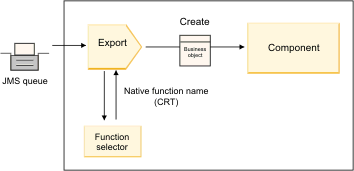IBM BPM, V8.0.1, All platforms > Get started with IBM BPM > Key concepts > Bindings > Export and import binding configuration
Function selectors in export bindings
A function selector is used to indicate which operation should be performed on the data for a request message. Function selectors are configured as part of an export binding.
Consider an SCA export that exposes an interface. The interface contains two operations–Create and Update. The export has a JMS binding that reads from a queue.
When a message arrives on the queue, the export is passed the associated data, but which operation from the export's interface should be invoked on the wired component? The operation is determined by the function selector and the export binding configuration.
The function selector returns the native function name (the function name in the client system that sent the message). The native function name is then mapped to the operation or function name on the interface associated with the export.
For example, in the following figure, the function selector returns the native function name (CRT) from the incoming message, the native function name is mapped to the Create operation, and the business object is sent to the SCA component with the Create operation.

If the interface has only one operation, there is no need to specify a function selector.
Several prepackaged function selectors are available and are listed in the sections that follow.
JMS bindings
The following table lists the function selectors that can be used with:
- JMS bindings
- Generic JMS bindings
- WebSphere MQ JMS bindings
| Function selector | Description |
|---|---|
| JMS function selector for simple JMS data bindings | Uses the JMSType property of the message to select the operation name. |
| JMS header property function selector | Returns the value of the JMS String Property, TargetFunctionName, from the header. |
| JMS service gateway function selector | Determines if the request is a one-way or two-way operation by examining the JMSReplyTo property set by the client. |
WebSphere MQ bindings
The following table lists the function selectors that can be used with WebSphere MQ bindings.
| Function selector | Description |
|---|---|
| MQ handleMessage function selector | Returns handleMessage as a value, which is mapped using the export method bindings to the name of an operation on the interface. |
| MQ uses JMS default function selector | Reads the native operation from the TargetFunctionName property of the folder of an MQRFH2 header. |
| MQ uses message body format as native function | Finds the Format field of the last header and returns that field as a String. |
| MQ type function selector | Creates a method in your export binding by retrieving a URL containing the Msd, Set, Type and Format properties found in the MQRFH2 header. |
| MQ service gateway function selector | Uses the MsgType property in the MQMD header to determine the operation name. |
HTTP bindings
The following table lists the function selectors that can be used with HTTP bindings.
| Function selector | Description |
|---|---|
| HTTP function selector based on the TargetFunctionName header | Uses the TargetFunctionName HTTP header property from the client to determine which operation to invoke at run time from the export. |
| HTTP function selector based on the URL and HTTP method | Uses the relative path from the URL appended with the HTTP method from the client to determine the native operation defined on the export. |
| HTTP service gateway function selector based on URL with an operation name | Determines the method to invoke based on the URL if "operationMode = oneWay" has been appended to the request URL. |
You can also create your own function selector, using IBM Integration Designer. Information about creating a function selector is provided in the IBM Integration Designer information center.
For example, a description of creating a function selector for WebSphere MQ bindings can be found in "Overview of the MQ function selectors".
Export and import binding configuration
Related information:
Overview of the MQ function selectors